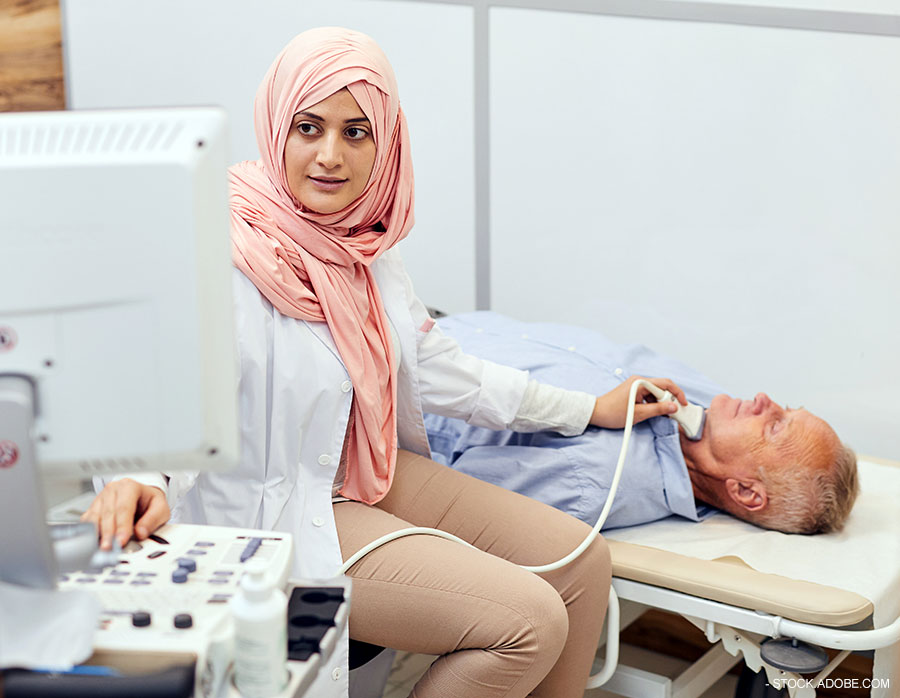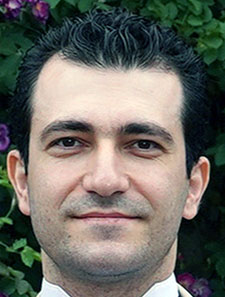 POCUS is a new column on point-of-care ultrasound. This column aims to explore evolving clinical applications, educational advancements, and the clinical impacts of POCUS through the insights of frontline hospitalists.
POCUS is a new column on point-of-care ultrasound. This column aims to explore evolving clinical applications, educational advancements, and the clinical impacts of POCUS through the insights of frontline hospitalists.
Point-of-care ultrasound (POCUS) has emerged as a critical tool in hospital medicine, offering real-time imaging that enhances diagnostic accuracy, facilitates the rapid detection of life-threatening conditions, and improves procedural precision.1 Its increasing adoption reflects its potential not only to elevate patient care but also to optimize healthcare efficiency by reducing diagnostic delays and minimizing reliance on more expensive imaging modalities.
The value of POCUS in clinical practice can be conceptualized as (Quality + Service)/Cost, confirming its ability to enhance diagnostic certainty, support bedside interventions, and lower overall healthcare expenditures. As a highly versatile, non-invasive modality, POCUS is transforming traditional diagnostic paradigms and becoming an indispensable asset in modern hospital medicine. Additionally, its portability enables clinicians to make critical decisions in time-sensitive scenarios, particularly in emergency and critical care settings.1
The expanding body of evidence supporting POCUS highlights its efficacy in guiding fluid management, vascular access, and assessment of cardiac and pulmonary conditions.1 Furthermore, its role in medical education continues to grow, equipping trainees and physicians with hands-on skills that improve patient safety and clinical outcomes. As healthcare systems strive for higher efficiency and cost-effectiveness, the integration of POCUS into routine practice represents a milestone in delivering high-quality, patient-centered care.
Clinical applications
POCUS enhances clinical decision making across various domains. In acute care settings, it aids in the rapid assessment of life-threatening conditions such as pneumothorax and cardiac tamponade, reducing diagnostic delays and allowing rapid, appropriate triage and treatments.2,3
Additionally, POCUS has revolutionized procedural guidance, improving safety and precision in procedures such as thoracentesis, paracentesis, and lumbar puncture.4-6 Furthermore, POCUS has also proved to assist with peripheral intravenous catheter placement in patients with difficult IV access, increasing accuracy and efficiency and decreasing complications by enhancing vein visibility and evaluation.7
POCUS proves valuable in dynamically assessing fluid status, cardiac function, and responses to interventions like fluid resuscitation.8 This ongoing utility supports its continued use in hospitalized patients, even when initially performed in the emergency department upon arrival. With that said, low-certainty evidence indicates that POCUS, when combined with the standard diagnostic pathway, improves sensitivity and specificity compared to the standard pathway alone.9
Impact on patient outcomes
The implementation of POCUS in hospital medicine, much like its established role in critical care and emergency medicine, has demonstrated measurable improvements in patient outcomes.9 Studies have shown that POCUS-guided procedures are associated with fewer complications, such as a lower incidence of pneumothorax during central venous catheterization and reduced bleeding risks in paracentesis, thereby enhancing procedural safety.5,10
POCUS has the potential to minimize the reliance on advanced imaging modalities, such as CT or MRI, which not only decreases radiation exposure but also contributes to overall cost reduction in healthcare. By expediting diagnosis and intervention, POCUS can potentially decrease length of stay and improve patient flow, and hence assist in optimizing bed utilization and resource allocation. As its role continues to expand, POCUS stands as a transformative tool that aligns with the goals of high-value, patient-centered care, reinforcing its indispensability in modern hospital medicine.9
The use of POCUS plays a vital role in bringing clinicians “back to bedside,” which usually leads to better patient experience and physician satisfaction. Also, the utility of POCUS cannot be overstated in rural and critical access hospitals, which usually lack radiology support.11 Patients from these hospitals are often transferred to secondary or tertiary care centers for imaging needs. Since these hospitals are usually staffed by one or two hospitalists, having POCUS skills can make an immense difference in patient outcomes by reducing the transfers and expediting patient care.
Education
The Accreditation Council for Graduate Medical Education (ACGME) does not currently mandate POCUS training as a part of the internal medicine (IM) residency curriculum, and as a result, many hospitalists are not certified in POCUS. However, IM residency curricula are increasingly integrating ultrasound training and promoting competency development among future healthcare professionals.12 The hospitalists are at the forefront of inpatient education for internal medicine residency programs, highlighting the critical need for POCUS skills among hospitalists. This starts during the residency program, so that recently graduated hospitalists usually have some working knowledge of POCUS. The hospitalists need to continue to sharpen their skills by taking regular courses and, most importantly, using POCUS on a day-to-day basis in their own clinical practice. This approach ensures that hospitalists gain practical experience that they can pass on to their trainees.12,13

SHM hosts POCUS learning sessions at Converge.
Challenges and considerations
Despite convincing evidence supporting POCUS’s potential, several challenges continue to hinder its widespread implementation. Variability in operator skills calls for standardized training protocols and competency assessments to ensure consistent and accurate performance across diverse clinical settings. In resource-limited environments, the prohibitive costs of equipment, maintenance, and infrastructure pose significant barriers to adoption, limiting access to this valuable diagnostic tool.14 Image archiving is important for quality assurance, accessibility, image comparison, and overall collaboration between healthcare practitioners. With various kinds of devices and electronic health records, this is challenging and expensive for the hospitals. The cost of devices, image archiving, and faculty training often must be weighed against POCUS’s other tangible benefits (like reducing length of stay, increasing patient experience scores, etc.). There is a need for more studies showing that POCUS utilization can mitigate these costs, bring positive revenue, and reduce diagnostic errors.
Additionally, disparities in training opportunities may lead to uneven proficiency among clinicians, further impacting the reliability of POCUS interpretations. While POCUS provides substantial clinical benefits, there is also a risk of over-reliance on its findings or misinterpretation due to limited experience, which could result in diagnostic errors or inappropriate management decisions.
To mitigate these risks, ongoing education, hands-on training, and robust quality assurance measures are critical to maintaining high standards of practice. Addressing these challenges through comprehensive training, technological advancements, and system-wide oversight will optimize the clinical utility of POCUS and reinforce its role as a cornerstone of modern bedside diagnostics.15
Future directions
POCUS is poised for significant advancements, driven by emerging technologies such as artificial-intelligence-assisted interpretation, miniaturized portable devices, and enhanced imaging resolution.16 Artificial intelligence integration holds tremendous potential in reducing operator variability, improving diagnostic accuracy, and facilitating broader adoption by providing real-time guidance and automated image analysis. The development of machine learning algorithms may assist clinicians in differentiating between subtle pathological findings and normal variations. Additionally, the incorporation of telemedicine capabilities into POCUS devices may expand access to expert interpretation, allowing for remote consultations and improved decision making in resource-limited settings.10,17
Certain operation initiatives, like the creation of a dedicated POCUS team staffed by a skilled hospitalist, can be an effective strategy. This team can assist the rounding teams by performing POCUS-guided procedures and diagnostic assistance, limiting interruptions for the rounding teams. Although not an absolute necessity, the relative value units generated from these procedures may even pay for the costs related to establishing a POCUS program. However, the utility of POCUS goes well beyond generating relative value units and instead creates positive value for patients, clinicians, and healthcare systems, which should be the driver of implementing such programs in the future. Furthermore, expanding educational initiatives and integrating POCUS training into medical curricula will be essential to maximizing its potential and ensuring widespread competency among healthcare providers. By incorporating technological advancements and robust clinical integration, POCUS is set to redefine bedside diagnostics and procedural guidance, reinforcing its indispensable role in the future of hospital medicine.10

Dr. Abou Asala

Dr. Singh
Dr. Abou Asala is a hospitalist and associate staff physician at the Cleveland Clinic in Cleveland. Dr. Singh is a hospitalist and associate staff physician in the department of hospital medicine at Cleveland Clinic Community Care in Mayfield Heights, Ohio.
SHM’s POCUS Certificate of Completion
If you’re an SHM member who primarily cares for acutely ill patients and you’re interested in improving your bedside ultrasound skills, SHM offers a Point-of-Care-Ultrasound (POCUS) Certificate of Completion (COC). The program, developed by SHM and CHEST, offers a comprehensive, hands-on experience to learn the fundamentals of point-of-care ultrasound. You can also take individual courses to enhance your POCUS skills without entering the COC program.
You must complete all of the following five program requirements (listed in the recommended order of completion) within three years of entering the program to earn your COC.
- Complete online modules—10-part series, “Principles of Point-of-Care Ultrasound” or CAE Healthcare’s online series, “Bedside Ultrasound in Critical Care” (SHM members receive special pricing on CAE Healthcare modules.)
- Attend Ultrasonography: Essentials in Critical Care—this is offered throughout the year at the CHEST Simulation Center in Glenview, Illinois. SHM members receive special pricing on this course.
- Attend an approved regional POCUS course—a multi-day, regional ultrasound course offered throughout the year in various parts of the country.
- Complete the online portfolio—candidates must assemble a portfolio of specific images to be reviewed and approved by an SHM faculty member online
- Take the Comprehensive Skills and Knowledge Assessments
- The SHM POCUS COC Steering Committee, currently led by Nilam J. Soni, MD, MS, Ria Dancel, MD, FAAP, FACP, SFHM, Ricardo Franco, MD, Linda M. Kurian MD, Charles LoPresti, MD, SFHM, Benji K. Mathews, MD, MBA, SFHM, Trevor Jenson, MD, and David Tierney, MD, FACP, develops and maintains the COC standards.
References
- Leidi A, et al. Point of care ultrasonography from the emergency department to the internal medicine ward: current trends and perspectives. Intern Emerg Med. 2020;15(3):395-408. doi: 10.1007/s11739-020-02284-5.
- Kim K, et al. Point-of-care AI-assisted stepwise ultrasound pneumothorax diagnosis. Phys Med Biol. 2023;68(20). doi: 10.1088/1361-6560/acfb70.
- Alerhand S, et al. Pericardial tamponade: A comprehensive emergency medicine and echocardiography review. Am J Emerg Med. 2022;58:159-174. doi: 10.1016/j.ajem.2022.05.001.
- Dancel R, et al. Recommendations on the use of ultrasound guidance for adult thoracentesis: a position statement of the Society of Hospital Medicine. J Hosp Med. 2018;13(2):126-135. doi: 10.12788/jhm.2940.
- Cho J, et al. Recommendations on the use of ultrasound guidance for adult abdominal paracentesis: a position statement of the Society of Hospital Medicine. J Hosp Med. 2019;14:E7-E15. doi: 10.12788/jhm.3095.
- Soni NJ, et al. Recommendations on the use of ultrasound guidance for adult lumbar puncture: a position statement of the Society of Hospital Medicine. J Hosp Med. 2019;14(10):591-601. doi: 10.12788/jhm.3197.
- Presley B, Isenberg JD. Ultrasound-guided intravenous access. In: StatPearls [Internet]. Treasure Island, FL: StatPearls Publishing; 2023. Available at: https://www.ncbi.nlm.nih.gov/books/NBK525988/. Last updated July 25, 2023. Accessed March 28, 2025.
- Maw AM, et al. Diagnostic accuracy of point-of-care lung ultrasonography and chest radiography in adults with symptoms suggestive of acute decompensated heart failure: a systematic review and meta-analysis. JAMA Netw Open. 2019;2(3):e190703. doi: 10.1001/jamanetworkopen.2019.0703.
- Qaseem A, et al. Appropriate use of point-of-care ultrasonography in patients with acute dyspnea in emergency department or inpatient settings: a clinical guideline from the American College of Physicians. Ann Intern Med. 2021;174(7):985-993. doi: 10.7326/M20-7844.
- Franco-Sadud R, et al. Recommendations on the use of ultrasound guidance for central and peripheral vascular access in adults: a position statement of the Society of Hospital Medicine. J Hosp Med. 2019;14(9):E1-E22. doi: 10.12788/jhm.3287
- Khaliq AA, et al. The Impact of hospital characteristics on the availability of radiology services at critical access hospitals. J Am Coll Radiol. 2015;12(12 Pt B):1351-6. doi: 10.1016/j.jacr.2015.09.008.
- Ramgobin D, et al. POCUS in internal medicine curriculum: quest for the holy-grail of modern medicine. J Community Hosp Intern Med Perspect. 2022;12(5):36-42. doi: 10.55729/2000-9666.1112.
- LoPresti CM, et al. Point-of-care ultrasound for internal medicine residency training: a position statement from the Alliance of Academic Internal Medicine. Am J Med. 2019;132(11):1356-1360. doi: 10.1016/j.amjmed.2019.07.019.
- Williams JP, et al. Current use, training, and barriers in point-of-care ultrasound in hospital medicine: A national survey of VA hospitals. J Hosp Med. 2022;17(8):601-608. doi: 10.1002/jhm.12911.
- Bernardi A, et al. Pitfalls and tips of clinical ultrasound. Rev Med Suisse. 2021;17(756):1842-1847. doi: 10.53738/REVMED.2021.17.756.1842.
- Kayarian F, et al. Artificial intelligence and point-of-care ultrasound: benefits, limitations, and implications for the future. Am J Emerg Med. 2024;80:119-122. doi: 10.1016/j.ajem.2024.03.023.
- Maw AM, et al. Point-of-care ultrasound and modernization of the bedside assessment. J Grad Med Educ. 2020;12(6):661-665. doi: 10.4300/JGME-D-20-00216.1.